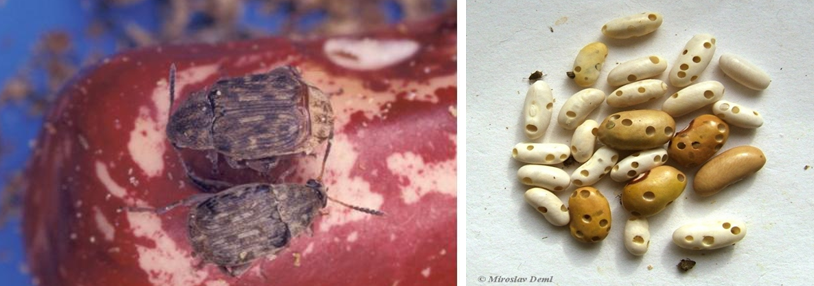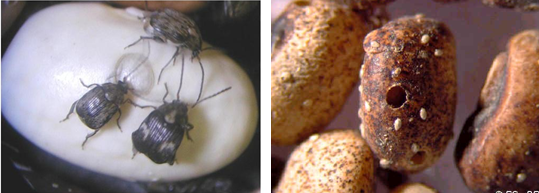CGKB News and events stog-forage-grass
Insects - forage grass
Contributors to this page are: CIAT, Colombia (Maritza Cuervo, Cesar Medina, Jose Luis Ramirez, Socorro Balcazar, Josefina Martinez, Daniel Debouck); ILRI, Ethiopia (Jean Hanson, Janice Proud, Juvy Cantrell).
|
Contents: |
Scientific names
Acantoscelides sp, A. obtectus, A. obvelatus, A. argillaceus
Significance
No precise information on losses in stored beans by bruchids is available. However, farm storage for six month is accompanied by about 40% loss in weight with as much as 80 % of the sees bein infested and unfit for human consumption. Losses vary between 7 % in Colombia to 73 % in Kenia.
The Bruchidae are adapted to attack the mature seeds of legumes, and those which attack food legumes demonstrate a certain degree of specialization to different legume species. The larva penetrates the seed and subsequent development. Takes place entirely within the seed cotyledons. The larva pupates within the seed but before doing so prepares the point of its eventual escape from the seed by chewing away a circular escape tunnel through the cotyledon leaving intact only the testa at the outside. This area of undermined testa can be seen clearly as a grey ‘window’.
Hosts
Is a widely distributed pest of storage beans.
Geographic distribution
Cosmpolitan.
Biology and transmission
Bean weevils are generally compact and oval in shape, with small heads somewhat bent under. Sizes range to 1 mm, up to 22 mm for some tropical species. Colors are usually black or brown often with mottled patterns. Although their mandible may be elongate they do not have long snouts. Adults deposit eggs on seeds, then the larvae chew their way into the seed. When ready to pupate, the larvae typically cut an exit hole, and then return to their feeding chamber. Adult weevils have a habit of feigning death and dropping from a plant when disturbed. Typically infest various kinds of beans, living for most of their lives inside a single seed. Acantoscelides obtectus and Acantascelides obvelatus – develop in Phaseolus vulgaris; Acantascelides argillaceus – develop in Phaseolus lunatus. A. obtectus predominates in cooler areas. Eggs are being laid on stored beans or in cracks of growing pods in the field. The larvae tunnel into the seeds to feed. Adult weevils are short-lived and do little feeding. A. obtectus is a better competitor than Zabrotes subfasciatus at lower temperatures and will eventually predominate under these conditions. A. obtectus females do not glue eggs to the test but scatter them among stored seeds or infest beans in the field by ovipositing on growing pods. The newly hatched larvae will later penetrate the seed. A. obtectus live 14 days and lay an average of 45 eggs.
Detection/indexing method in place at the CGIAR Center at CIAT
- Direct visual inspection
Treatment/control
- The actual chemical control of harmful species from Coleoprera Order is acceptable only in some and verylimited situations, and inacceptable in the majority of cases for the residual toxicity The following controls are recommended: Preventive measures of control: building repairs, overall cleaning measures, specific preventive measures, physical treatments; Preventive measures applied when introducing the products into the storehouse; Periodical supervision measures Curative, non-polluting measures (dehydration powders, means of entheroleter, means of pheromone traps, use of microwave electromagnetic generators, use of strong electric fields and “corona” discharges in alternative current, use of vegetal insecticides.
Procedure followed at the centers in case of positive test
- Not noted
References and further reading
Porca M, Ghizdavu I, Oltean I, Bunescu H. 2003. Control of the coleopteres in stored agricultural products bynot-chemical methods. Journal of Central European Agriculture (online), 218 Volume 4 (2003) No3.
Seed Health General Publication Published by the Center or CGIAR
 Acanthoscelides obtectus (photos: Beans Entomology, CIAT and Miroslav Deml, Biolib) |
Scientific names
Zabrotes spp. Zabrotes subfasciatus (Boheman)
Other names
Zabrotes pectoralis (Sharp), Spermophagus subfasciatus Boheman, Spermophagus musculus Boheman, Spermophagus pectoralis Sharp, Spermophagus semifasciatus Boheman.
Significance
It is the most important pest of storage beans in warmer regions.
Symptoms
Not noted
Hosts
Beans, vigna unguiculata (cowpea). All the known hosts of Zabrotes are in the Fabaceae with a questionable record in the Bixaceae.
Geographic distribution
Cosmopolitan. Ii is a tropical species and is found predominantly in warmer areas.
Biology and transmission
Zabrotes subfasciatus attaches the egg to the seed. After hatching, the young larvae bore through their egg shell and the seed coat in one process. Zabrotes subfasciatus does not attack in the field. Adults exhibit strong sexual dimorphism. Females are large and have fourcharacteristic crfeam-colored spots on the elytra. The male is entirely brown. At 28 oC and 75%-80% r.h., females lay an average of 36 eggs and live 13 days. The egg stage lasts five to six days, larval development takes 14 days, and the pupal stage takes six to seven days.
Detection/indexing method in place at the CGIAR Center at CIAT
- Direct visual inspection
Treatment/control
- The actual chemical control of harmful species from Coleoprera Order is acceptable only in some and verylimited situations, and inacceptable in the majority of cases for the residual toxicity The following controls are recommended: Preventive measures of control: building repairs, overall cleaning measures, specific preventive measures, physical treatments; Preventive measures applied when introducing the products into the storehouse; Periodical supervision measures Curative, non-polluting measures (dehydration powders, means of entheroleter, means of pheromone traps, use of microwave electromagnetic generators, use of strong electric fields and “corona” discharges in alternative current, use of vegetal insecticides.
References of protocols at EPPO, NAPPO or other similar organization
Porca M*, Ghizdavu I, Oltean I, Bunescu H. 2003. Control of the coleopteres in stored agricultural products bynot-chemical methods. Journal of Central European Agriculture (online), 218 Volume 4 (2003) No3.
 Zabrotes subfasciatus (photos: CIAT and http://entmuseum9.ucr.edu/) |
Weeds (Forage grasses)
Weeds
Phytoplasma - forage grass
Contributors to this page are: CIAT, Colombia (Maritza Cuervo, Cesar Medina, Jose Luis Ramirez, Socorro Balcazar, Josefina Martinez, Daniel Debouck); ILRI, Ethiopia (Jean Hanson, Janice Proud, Juvy Cantrell).
Napier Grass Stunt Disease
Scientific name
Phytoplasma belonging to 16SrXI (rice yellow dwarf) group; 16Sr111 group
Significance
Reduction in plant biomass by 20 to 40% poses a major problem to small-holder cattle producers (milk and meat). It is threatening the livestock industry and food security in east and central Africa.
Symptoms
Etiolation, reduction in leaf size, proliferation of tillers and shortened internodes
Hosts
Pennisetum purpureum, Medicago sativa, Cynodon dactylon
Geographic distribution
East and Central Africa
Biology and transmission
The method of plant propagation and the presence of insect vectors promote the spread of NGSD over long distances. Napier grass produces small, unviable seeds thus propagation is vegetative either by stem cutting or clump splitting.
Transmission of the pathogen among plants is facilitated by leafhoppers. Leafhoppers generally spend their life on one plant but can transfer to another plant during cropping or when blown by wind. Transmission of pathogen in plants happens after the latent period when phytoplasma multiplies in the body and migrates to the salivary glands of the insect. While feeding on phloem sap, the insect inoculate the pathogen into the plant.
Strains were most similar (96%) to Bermuda grass white leaf phytoplasma (Accession 16388).
Detection/indexing method in place
- at CIAT: Not applicable
- at ILRI: NASH, PCR method
Treatment/control
- If the disease is present then all symptomatic plants should be removed and burnt.
- Measures to control the spread of NGSD can be effective only if there is sufficient knowledge on vector lifecycle in relation to phytoplasma transmission.
- For high infection check for disease free seeds tillers to re-establish plots.
Procedure followed at the centers in case of positive test
- All individual plants tested, clean plants retained and infected plants rogued and material burnt
References and further reading
Arocha Y, Zerfy T, Abebe G, Proud J, Hanson J, Wilson M, Jones P, Lucas J. 2008. Identification of Potential Vectors and Alternative Plant Hosts for the Phytoplasma Associated with Napier Grass Stunt Disease in Ethiopia. Journal of Phytopathology. Published Online: 11 Nov 2008.
Diekmann M, Putter CAJ. (eds.) 1995. FAO/IPGRI Technical Guidelines for the Safe Movement of Germplasm. No. 14. Small Grain Temperate Cereals. Food and Agriculture Organization of the United Nations, Rome/International Plant Genetic Resources Institute, Rome.
Frison EA, Putter CAJ. (eds.). 1993. FAO/IBPGR Technical Guidelines for theSafe Movement of Sugarcane Germplasm. Food and Agriculture Organization of the United Nations, Rome/ International Board for Plant Genetic Resources, Rome.
Jones P, Arocha Y, Zerfy T, Proud J, Abebe G, Hanson J. 2007. A stunting syndrome of Napier grass in Ethiopia is associated with a 16SrIII Group phytoplasma, Plant Pathology, 56, 345.
Jones P, Devonshire BJ, Holman TJ, Ajanga S. 2004. Napier grass stunt: a new disease associated with a 16SrXI Group phytoplasma in Kenya. [online] Available from URL: http://www.bspp.org.uk/ndr/july2004/2004-19.asp Date accessed 13 April 2010
Mulaa M. Nov. 2004. A Survey to Collect and Identify Potential Vectors of Napier Grass stunting disease Associated with Phytoplasma in Western Kenya. Nov. 25-29, 204. ILRI, Unpublished material.



 stog-forage-grass
stog-forage-grass
